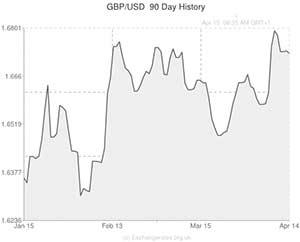
Yesterday the US Dollar gained against the majority of its most traded rivals as US retail sales surprised to the upside, and today more positive US news helped the ‘Greenback’ extend its advance against the Pound.
On Monday US retail sales were shown to have surged by 1.1 per cent in March rather than increasing by the 0.9 per cent projected.
The GBP to USD exchange rate slipped further during European trading today as a report showed that UK inflation hit an over four-year low, remaining below the Bank of England’s 2 per cent target and supporting the case for the central bank holding off on increasing interest rates.
Later on Tuesday the US Dollar rallied for a third day as the US consumer price index climbed by more-than-forecast.
Although economists expected the US consumer price index to advance by 0.1 per cent month-on-month in March it actually rose by 0.2 per cent.
On the year the consumer price index increased by 1.5 per cent, more than the 1.4 per cent forecast.
The ‘Greenback’ extended gains against the Australian Dollar and pushed higher against the Euro.
In the opinion of currency strategist Michael Sneyd; ‘This week’s focus is on US data, which should support a rebound in the Dollar. There’s still a bit of excitement following yesterday’s retail sales numbers. It’s likely to be quite an important week.’
Separate US reports revealed that US empire manufacturing came in at 1.3 in April, down from 5.6 in March and less than the 8.0 per cent expected.
As the week progresses there are several other highly influential US economic reports to take into account, including tomorrow’s housing starts, building permits and industrial production data.
Investors will also be taking a keen interest in two speeches to be given by Federal Reserve Chairman Janet Yellen.
Additionally, Pound to US Dollar fluctuations may be dictated by UK employment figures.
The data is predicted to show that the UK economy added 90,000 positions in the three months to February, with the nation’s unemployment rate declining from 7.2 per cent to 7.1 per cent.
Average weekly earnings are believed to have climbed by 1.8 per cent in the three months to February compared with the same period of the previous year while weekly earnings excluding bonuses climbed 1.7 per cent.
US Dollar (USD) Exchange Rates
[table width=”100%” colwidth=”50|50|50|50|50″ colalign=”left|left|left|left|left”]
Currency, ,Currency,Rate ,
US Dollar, ,Pound Sterling,0.5976,
,Pound Sterling,0.5976,
US Dollar, ,Canadian Dollar,1.1003,
,Canadian Dollar,1.1003, 
US Dollar, ,Euro,0.7244,
,Euro,0.7244,
US Dollar, ,Australian Dollar,1.0679,
,Australian Dollar,1.0679,
US Dollar, ,New Zealand Dollar,1.1570 ,
,New Zealand Dollar,1.1570 ,
Canadian Dollar, ,US Dollar ,0.9098,
,US Dollar ,0.9098,
Pound Sterling, ,US Dollar,1.6735,
,US Dollar,1.6735,
Euro, ,US Dollar,1.3795,
,US Dollar,1.3795,
Australian Dollar, ,US Dollar,0.9366,
,US Dollar,0.9366,
New Zealand Dollar, ,US Dollar,0.8662 ,
,US Dollar,0.8662 ,
[/table]

Comments are closed.